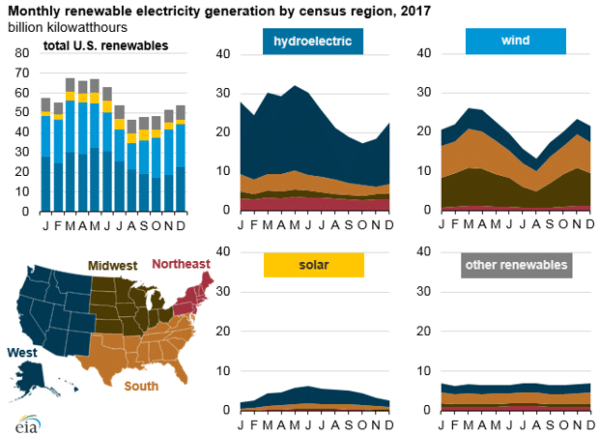Germany has been a global leader in many aspects of the transition to renewable energy, including both deployment policies and strategies for grid integration. One aspect of the nation’s Energiewende (Energy Turn or Transition) that is often underestimated is the deployment of complementary volumes of wind and solar, so that the overall amount of renewable energy has been relatively stable on a seasonal basis for many years – although the dismantling of policy support for solar may have pushed the balance in the direction of excess wind in 2017.
By contrast, the United States is seeing more of an unplanned, free-market transition to renewables, driven by a combination of tax policies, largely resource-agnostic renewable energy mandates, and raw economics. And as an analysis from the U.S. Department of Energy’s Energy Information Administration (EIA) shows, this led to a seasonal imbalance in the aggregate output of renewable energy sources in 2017.
2017 saw particularly high levels of hydro output, due to a very wet winter in Western States. This peaked during the late Spring with the nation’s hydroelectric dams generating more than 30 terawatt-hours (TWh) in May alone, and falling to around half that level by October.
However, wind also displayed a seasonal pattern, with a national aggregate output of around 25 TWh each month in March and April, falling to only 15 TWh in August. By contrast solar peaked in June at around 6 TWh. The net result was that total U.S. renewable output peaked in March, April and May and fell to its lowest level during August.

July and August are the hottest months of the year, and as such electricity demand, driven by widespread use of air conditioning, peaks during these months. This means that the output of renewable energy in the United States is following a seasonal pattern that is mismatched with demand. Additionally summer peak demand, which could be served by solar, is in many regions largely being met with costly power from “peaker” gas plants and imports of electricity.
Furthermore, deployment of renewable energy is not evenly spread across the United States. The West holds the bulk of the nation’s hydroelectric power and solar, and wind is concentrated in the Great Plains, Midwest, and Texas.
This means that issues with seasonal mismatch were even more pronounced in the West. For years higher levels of hydroelectric output during the Spring have driven curtailment of solar in California, as daytime temperatures are not yet high enough to lead to higher demand from air conditioning. This includes during Spring 2017, due to high levels of hydroelectric power and growing solar output.
Solutions
More solar is a partial solution to the problem of seasonal mismatch. This would be particularly meaningful in the Midwest, Plains States and Texas, where solar can balance the output of wind on a seasonal basis. In Texas and the Midwest, large-scale deployment of solar is beginning to take off, with Michigan and Minnesota leading the Midwest. However, despite ample sunlight the Plains States still lag the rest of the nation.
Additional policy support may be needed to meet this deployment. Capacity payments in Texas’ grid value solar more highly than wind, but may not be enough to meet the mismatch.
For all of this to provide benefits on a wider geographical basis it will be necessary to have the infrastructure and market design to rapidly move and trade electricity across regions. The Federal Energy Regulatory Commission is tracking more than 4,600 miles of new transmission projects that it gives a high probability of being completed over the next two years. This is nearly 20-times the length completed in the first 11 months of 2017.
As for balancing this power, California’s grid operator has been moving in this direction for several years with the Energy Imbalance Market, which facilitates such rapid trading of electricity with a network of grid operators in Western states.
Over the long run in California, it may also be necessary to reform contracts for hydroelectric power, so that the daily pattern of hydro complements solar output. However this will do little for the seasonal problem, and for the foreseeable future California and the West will have a glut of power during the spring.
This represents a tremendous opportunity for entrepreneurs with business models that can take advantage of negative prices and/or free power during this time.
This content is protected by copyright and may not be reused. If you want to cooperate with us and would like to reuse some of our content, please contact: editors@pv-magazine.com.









By submitting this form you agree to pv magazine using your data for the purposes of publishing your comment.
Your personal data will only be disclosed or otherwise transmitted to third parties for the purposes of spam filtering or if this is necessary for technical maintenance of the website. Any other transfer to third parties will not take place unless this is justified on the basis of applicable data protection regulations or if pv magazine is legally obliged to do so.
You may revoke this consent at any time with effect for the future, in which case your personal data will be deleted immediately. Otherwise, your data will be deleted if pv magazine has processed your request or the purpose of data storage is fulfilled.
Further information on data privacy can be found in our Data Protection Policy.